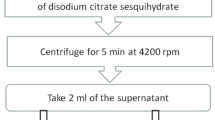Abstract
Honey is a natural food and widely used for its nutritional and therapeutic properties. The occurrence of pesticides in honeybees causes a potential risk for consumers. In the current study, LC–MS/MS and GC/MS methods were optimized for analysis of 46 multiclass pesticides residues in honey samples. The effect of different extraction solvents and dispersive solid phase extraction (DSPE) purification on the analytical methods performance were investigated. Acetonitrile performed better than ethyl acetate in terms of method efficiency and decreasing of matrix effects, while DSPE was effective in reducing matrix effect. The analytical methods were validated according to European Commission guidelines, in terms of accuracy, repeatability, reproducibility, linearity, LOD and LOQ. The methods were applied to 52 honey samples collected from northern and southern governorates of Egypt. Detectable levels of penconazole, difenoconazole, metalaxyl and carbofuran residues were found, in the range of 3–30 µg/kg, in 14 % of the samples. These results indicate that the tested honey samples are safe for human consumption, taking into account the effect of environmental conditions of the honey’s production region on the pesticides contamination levels.



Similar content being viewed by others
References
Abdel Ghani SB, Abdallah OI (2016) Method validation and dissipation dynamics of chlorfenapyr in Squash and Okra. Food Chem 194:516–521. doi:10.1016/j.foodchem.2015.08.053
Bletsou AA, Hanafi AH, Dasenaki ME, Thomaidis NS (2013) Development of specific LC–ESI-MS/MS methods to determine bifenthrin, lufenuron, and iprodione residue levels in green beans, peas, and chili peppers under Egyptian field conditions. Food Anal Methods 6:1099–1112. doi:10.1007/s12161-012-9515-2
Chauzat MP, Martel AC, Cougoule N, Porta P, Lachaize J, Zeggane S, Aubert M, Carpentier P, Faucon JP (2011) An assessment of honeybee colony matrices, Apis mellifera (Hymenoptera: Apidae) to monitor pesticide presence in continental France. Environ Toxicol Chem 30:103–111. doi:10.1002/etc.361
Chen M, Tao L, McLean J, Lu C (2014) Quantitative analysis of neonicotinoid insecticide residues in foods: implication for dietary exposures. J Agric Food Chem 62:6082–6090. doi:10.1021/jf501397m
Choudhary A, Sharma DC (2008) Dynamics of pesticide residues in nectar and pollen of mustard (Brassica juncea (L.) Czern.) grown in Himachal Pradesh (India). Environ Monit Assess 144:143–150. doi:10.1007/s10661-007-9952-3
European Commission Regulation (396/2005/EC) on maximum residue levels of pesticides in or on food and feed of plant and animal origin and amending Council Directive 91/414/EEC (2005). http://eurlex.europa.eu/LexUriServ/LexUriServ.do?uri=OJ:L:2005:070:0001:0016:en:PDF. Accessed 16 June 2017
European Food Safety Authority (2012) Pesticides and bee health: EFSA reviews the science. EFSA J 10:2668–2943. doi:10.2903/j.efsa.2012.2668
Frenich AG, Romero-Gonzalez R, Mar Aguilera-Luiz M (2014) Comprehensive analysis of toxics (pesticides, veterinary drugs and mycotoxins) in food by UHPLC–MS. TrAC Trends Anal Chem 63:158–169. doi:10.1016/j.trac.2014.06.020
Grimalt S, Dehouck P (2016) Review of analytical methods for the determination of pesticide residues in grapes. J Chromatogr A 1433:1–23. doi:10.1016/j.chroma.2015.12.076
Hanafi A, Elsheshetawy HE, Faied S (2016) Reduction of pesticides residues on okra fruits by different processing treatments. J Verbr Lebensm 11:337–343. doi:10.1007/s00003-016-1054-0
Kasiotis KM, Anagnostopoulos C, Anastasiadou P, Machera K (2014) Pesticide residues in honeybees, honey and bee pollen by LC–MS/MS screening: Reported death incidents in honeybees. Sci Total Environ 485:633–642. doi:10.1016/j.scitotenv.2014.03.042
Kujawski MW, Namiesnik J (2008) Challenges in preparing honey samples for chromatographic determination of contaminants and trace residues. TrAC Trends Anal Chem 27:785–793. doi:10.1016/j.trac.2008.07.004
Lehotay SJ (2007) Determination of pesticide residues in foods by acetonitrile extraction and partitioning with magnesium sulfate: Collaborative study. J AOAC Int 90:485–520
Lucini L, Molinari GP (2011) Performance and matrix effect observed in QuEChERS extraction and tandem mass spectrometry analyses of pesticide residues in different target crops. J Chromatogr Sci 49:709–714. doi:10.1093/chrsci/49.9.709
Malhat FM, Haggag MN, Loutfy NM, Osman MAM, Tawfic AM (2015) Residues of organochlorine and synthetic pyrethroid pesticides in honey, an indicator of ambient environment, a pilot study. Chemosphere 120:457–461. doi:10.1016/j.chemosphere.2014.08.032
Masia A, Suarez-Varela MM, Llopis-Gonzalez A, Pico Y (2016) Determination of pesticides and veterinary drug residues in food by liquid chromatography-mass spectrometry: a review. Anal Chim Acta 936:40–61. doi:10.1016/j.aca.2016.07.023
Panseri S, Catalano A, Giorgi A, Arioli F, Procopio A, Britti D, Chiesa LM (2014) Occurrence of pesticide residues in Italian honey from different areas in relation to its potential contamination sources. Food Control 38:150–156. doi:10.1016/j.foodcont.2013.10.024
Pirard C, Widart J, Nguyen BK, Deleuze C, Heudt L, Haubruge E, De Pauw E, Focant JF (2007) Development and validation of a multi-residue method for pesticide determination in honey using on-column liquid–liquid extraction and liquid chromatography–tandem mass spectrometry. J Chromatogr A 1152:116–123. doi:10.1016/j.chroma.2007.03.035
Porrini C, Ghini S, Girotti S, Sabatini AG, Gattavecchia E, Celli G (2002) Use of honey bees as bioindicators of environmental pollution in Italy. In: Devillers J, Pham-Delegue M (eds) Honey bees: estimating the environmental impact of chemicals. Taylor & Francis Inc, London, pp 186–247
SANTE/11945/2015, Guidance document on analytical quality control and method validation procedures for pesticide residues analysis in food and feed. European Commission, Directorate-general for Health and Food Safety, Safety of the Food Chain Chemicals, Pesticides and Biocides, 2015. http://ec.europa.eu/food/plant/docs/pesticides_mrl_guidelines_wrkdoc_11945.pdf.Accessed 16 June 2017
Shendy AH, Al-Ghobashy MA, Mohammed MN, Gad Alla SA, Lofty HM (2016) Simultaneous determination of 200 pesticide residues in honey using gas chromatography–tandem mass spectrometry in conjunction with streamlined quantification approach. J Chromatogr A 1427:142–160. doi:10.1016/j.chroma.2015.11.068
Stubbing SB, Bigwood T (2009) The development and validation of a multiclass liquid chromatography tandem mass spectrometry (LC–MS/MS) procedure for the determination of veterinary drug residues in animal tissue using a QuEChERS (QUick, Easy, CHeap, Effective, Rugged and Safe) approach. Anal Chim Acta 637:68–78. doi:10.1016/j.aca.2009.01.029
Author information
Authors and Affiliations
Corresponding author
Ethics declarations
Conflict of interest
The authors state that they have no conflict of interest.
Electronic supplementary material
Below is the link to the electronic supplementary material.
Rights and permissions
About this article
Cite this article
Abdallah, O.I., Hanafi, A., Abdel Ghani, S.B. et al. Pesticides contamination in Egyptian honey samples. J Consum Prot Food Saf 12, 317–327 (2017). https://doi.org/10.1007/s00003-017-1133-x
Received:
Accepted:
Published:
Issue Date:
DOI: https://doi.org/10.1007/s00003-017-1133-x




